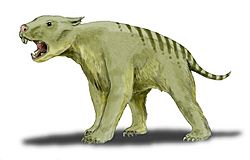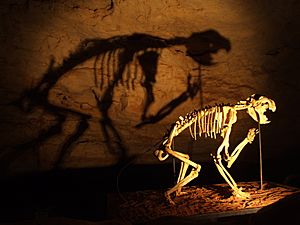Marsupial lion facts for kids
Quick facts for kids Marsupial lionTemporal range: Pleistocene
|
|
|---|---|
 |
|
| Scientific classification | |
| Kingdom: | |
| Phylum: | |
| Class: | |
| Infraclass: | |
| Order: | |
| Genus: |
Thylacoleo
|
| Species: |
T. carnifex
|
| Binomial name | |
| Thylacoleo carnifex Owen, 1859
|
|
The Marsupial lion, also known as Thylacoleo, was a meat-eating marsupial that lived in Australia. It is now extinct, meaning it no longer exists. This powerful animal roamed Australia from about 1.6 million to 46,000 years ago. It was the biggest meat-eating marsupial to ever live in Australia.
Scientists found fossils on the dry Nullarbor Plain. These fossils suggest that humans and changes in the weather might have caused the extinction of many large Australian animals, called Australian megafauna, around 45,000 years ago.
This animal was very strong and muscular. It had powerful jaws and very strong front legs. The Marsupial lion had claws that could be pulled back, like a cat's. This was special because most marsupials don't have retractable claws. This feature helped keep its claws sharp by protecting them when it walked.
Its claws were perfect for holding onto prey and for climbing trees. The first "thumb" digits on each hand were partly opposable. They had a large claw. Scientists think this helped the Marsupial lion grab its prey. It also helped it get a good grip on tree trunks and branches.
The Marsupial lion had incredibly strong claws and very powerful jaws. Biologists believe it had the strongest bite of any mammal, whether alive today or extinct. It could hunt large animals like the giant kangaroo and the giant wombat. However, its big jaw might have made it hard to hunt smaller animals.
The Marsupial lion could weigh up to 130 kg (287 lb). It was about 1.5 m (5 ft) long. It stood about 75 cm (2 ft) tall.
Discovering Marsupial Lion Fossils
Fossil bones of the Marsupial lion have been found in caves on the Nullarbor Plain. Scientists have estimated these bones to be between 400,000 and 800,000 years old.
In 2006, cave art was found in northwest Australia. These paintings show Marsupial lions with striped backs, tufted tails, and pointed ears. This gives us clues about what they looked like.
In 2009, a farmer near Ballarat in southeast Victoria made an exciting discovery. A long drought had dried out many lakes. The farmer found fossil footprints and a jawbone of a Marsupial lion. They were preserved in limestone in a dry lake bed.
Images for kids
-
Restoration of Thylacoleo attacking Diprotodon.
See also
 In Spanish: Thylacoleo para niños
In Spanish: Thylacoleo para niños






